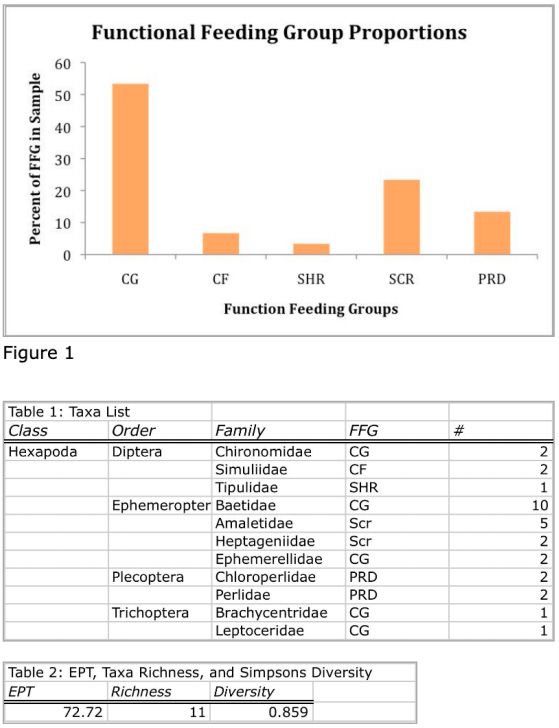Big Creek is a tributary of the Chilko-Chilcotin River in the interior of British Columbia. Documents describing the aquatic macroinvertebrate fauna of the creek are scant to non-existent. To compile a list of taxa and tabulate common insect metrics a three kick composite sample was taken. Only riffle habitat above the confluence with the Chilko-Chilcotin River was sampled. Although there was a diversity of substrates within Big Creek, only cobble/gravel habitat was used. Aquatic invertebrates were identified down to family in the field. Using family level data, aquatic invertebrate metrics were calculated: percent Ephemeroptera, Plecoptera, and Trichoptera (EPT), functional feeding group proportions (FFGs), taxa richness (the number of families present), and Simpsons Index of Diversity.
Big Creek is an excellent stream for gill breathing insects such as Ephemeroptera, Plecoptera, and Trichoptera, due to its cold and clear water. Cold water has higher dissolved oxygen, which allows gill breathers to flourish. Similarly the clarity of the water shows that there is little suspended sediment. Sediment interferes with the respiration of gill breathing insects. These two characteristics are reflected by the majority of insects being gill breathers, with a percent EPT of 72.72%. Although the majority of the taxa found were in the EPT, the site had high diversity and taxa richness (Table 1). These three metrics and their values indicate that the water quality of stream is good, creating the right conditions for a diverse invertebrate community.
An interesting aspect of the creek was its diversity in feeding groups. Collector gathers, collector filterers, shredders, scrapers, and predators were all present within the riffle habitat. Collector gatherers, especially baetids, dominated the stream. The high proportion of collector gatherers indicates that there was a large amount of available fine particulate organic matter (FPOM). Similarly collector filterers were also found, their presences shows that FPOM was in suspension. The second highest FFG were scrapers. Scraping invertebrates feed on attached periphyton and are limited by periphyton growth. Periphyton was found due to the clear water and width of the stream. Decreased shading and clear water allows solar radiation to reach the substrates, facilitating periphyton growth. Shredders were also found and require coarse particulate organic matter (CPOM) as a food resource. Predators, which feed on animal matter, were found within the sample.
The stream's high diversity, taxa richness, and EPT may be due to the presence of diverse food resources as indicated by the functional feeding groups found. Diversity of resources and good water quality provides habitat for an array of insects, accommodating many different life history patterns. It should also be noted that the stream contained many other habitats, such as pools and calm waters. These habitats were observed to have invertebrate taxa not found in the riffle sample.

